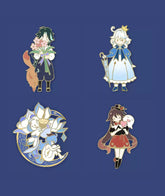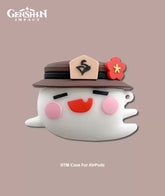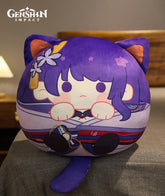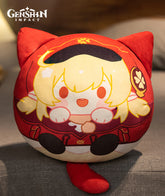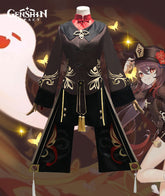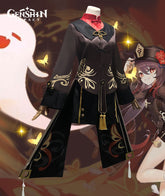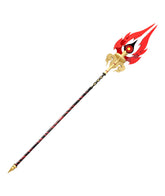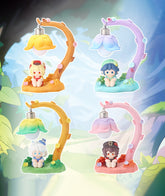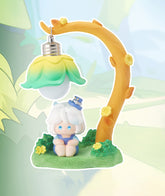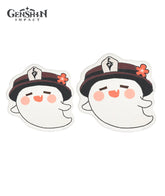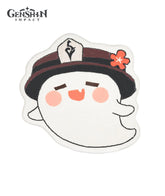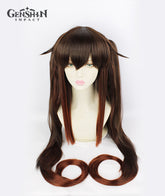Hu Tao's Character Design: Did You Notice These Details?
"77th Director of the Wangsheng Funeral Parlor"-Hu Tao, As a young girl with a quirky and lively personality, who wouldn't like it?
But the mysterious Director of the Wangsheng Funeral Parlor, do you really know her? So let's explore Hu Tao's little secret together!

Fragrance in Thaw, which is translated in Chinese as "Smell the plum blossoms after the snow stops falling", can be interpreted as growth after setbacks. Probably, Hu Tao's growth began with the first funeral she organized.
1. Hu Tao Hat
I wonder how many of travelers have wondered about what is the "two strips" of cloth under Hu Tao's "hexagonal hat"?

This form is similar to a type of female scarf turban popularized in China during the Tang Dynasty, which was more commonly used among female officials, ladies-in-waiting and noble women in the palace. While the phenomenon was partly a desire for masculinity, it was overall a recognition of female gender roles. The "foot" of the turban refers to the remaining part of the two straps that are tied behind the head.
Perhaps this turban, like the recognition of women in the Tang Dynasty, also symbolizes the recognition of Hu Tao by the older generation in the Wangsheng Funeral Parlor.
2. Hu Tao: Moment of Bloom

Hu Tao's Character Event Wish is called "Moment of Bloom", and in the Chinese version it is called "Moment of Red Flower Ball Bloom". What is a "Red Flower Ball"? From the Dharma Flower Sutra, "What is Manjusaka? The Red Flower Ball." Manjusaka (Sanskrit: Mañjusaka) is one of the four "flowers of the heavenly realm" of the Buddha's teachings, with no specific image.
The association of "Manjusaka" with "Lycorisradiata" is an allusion that Japan, having been baptized in the Buddhist religion, has applied to the red lycorisradiata , which is very common in their surroundings. It was probably thought that its brilliant red color and clusters of radiant corollas really fit the image of the "Red Flower Ball".

3. Hu Tao's Butterfly and Past Life
Butterflies are often seen as manifestations of human ghosts in Eastern cultures.
There is a popular Japanese play that seems to have evolved from the concept of a ghost turning into a butterfly. The butterfly is a beautiful woman who committed suicide after being falsely accused of a crime and abused. Those who wanted to avenge her death could not find the person who did it to her. However, the hairpin of the dead woman transformed into a butterfly, which flew above the place where the evil man was hiding and guided them to catch him, thus avenging his death.

Before they were exposed to Chinese, the Japanese had their own language, but the word "butterfly" doesn't have a Kun'yomi in modern Japanese.
The answer to this question can be found in entomologist こにし まさやす's book, "虫の文化誌".

In ancient Japan, there used to be a Kun'yomi for "butterfly", and the most common Kun'yomi used in the Heian period was "kawahirako", or "hihiru", either of which, like Voldemort's name, must never be mentioned, but must be replaced by "You Know Who". Because the Japanese at that time believed that butterflies were the souls of the dead, wandering in the world, looking for the living to bring into the realm of the dead, so everyone talked about butterflies, the word "butterfly" as a forbidden word, never open mouth to mention it, and over time, even the pronunciation of this word itself is almost lost, and finally expelled from the Japanese language in the modern Japanese language. ...... The same thing happened to the word "moth", which was also included in the list of demons because it is related to butterfly.
The change in the imagery of the butterfly originated with the introduction of Buddhism. The Shingon Buddhism believes that butterflies are soul carriers, capable of carrying the souls of the departed to the Pure Land of Ultimate Bliss, and that reincarnation is accomplished through the butterfly's transportation.
Butterflies symbolize reincarnation, originating from the phenomenon of butterfly metamorphosis, that is, people's associations triggered from the feathering and metamorphosis of butterflies, so the butterfly imagery has common features in both Eastern and Western cultures. For example, in Greek culture, the larva of the butterfly is a metaphor for the human body in the present life, the chrysalis represents death, and the feathering into a butterfly is the sublimation of the soul after death; in Christian allegory, the caterpillar, the chrysalis, and the butterfly symbolize life, death, and resurrection respectively. The life course of a butterfly is itself a process from life to death and then from death to resurrection. For the butterfly, the death of the chrysalis is not the end of life, but the beginning of another kind of life, and people have found some kind of a fit with the idea of death and resurrection in the butterfly's metamorphosis process.
The main significance of reincarnation in Japanese culture is the resurrection from the dead, and the reason why death is regarded as beautiful is because death is the continuation of life. The Japanese literary critic こが‐はるえ said, "There is no higher art than death; death is life." This is a view of life and death rooted in Japanese national culture, life and death in Japanese culture are two different ways of life, death does not mean the end of life, but another state of life existence, but also a new starting point and sublimation.
4. Funeral Culture
"The people of Liyue are the most tradition-oriented, and these traditions and culture are condensed in the various rituals of their lives"
"The main event is the funeral that announces the end of life."
"There are a lot of funeral rituals."
This is the Confucian idea of emphasizing death and mourning death, regardless of whether the ghosts and gods are considered to be present or absent, all emphasize mourning, burial and sacrifice in accordance with the rituals, thus advocating benevolence and filial piety as the kernel of the system of etiquette.

Hu Tao's view of life and death, on the other hand, is derived from the Tao(m) school of thought. First of all, Zhuang Zi believed that "life and death have the same destiny". Zhuangzi believes that since human life and death are as inescapable as the eternal alternation of day and night, death is the inevitable result of conforming to heaven's will; Zhuangzi also believes that "life and death are on the same path". Zhuang Zi's transcendental attitude towards death also lies in his belief that life and death go hand in hand, and that if death is the end of life, then death is also the beginning of life. Because life and death go hand in hand, if survival is regarded as a good thing, then death should also be regarded as a good thing; if death is regarded as a sad thing, then life is also sad.
Hu Tao is always quirky, her ghost ideas frequently, but in the funeral ceremony and serious, even if they think "life and death with the road", but also abide by the etiquette, seriously do a good funeral.
5. Wangsheng Seal and Plum Blossom
In Hu Tao's PV, the "Seal of Wangsheng" hand seal appears, which is derived from the hand seal of the Zhengyi Dao.

Hu Tao's hat has a branch of plum blossoms on it. Plum blossom in Taoism in a very special position, almost become synonymous with Taoism. Taoism enshrines the Heavenly Highest Deity is the god of the north, but also the god of water, the five elements of water, the five colors are black, the cold of winter is pure Yin, this time the plum blossom tree alone, heralding the extreme yang to come. Therefore, Plum Blossom is chosen as the mascot of Heavenly Highest Deity among all flowers.
It is worth mentioning that Genshin Impact has officially released quite a number of Hu Tao merchandise including the stylish Hu Tao clothes. Hu Tao plum blossom rings and brooches are small and elegant, suitable for wearing even in daily life, adding a touch of color to your dress wear.
If you are fond of exquisite jewelry, consider this highly sought-after Hu Tao ring. Its unique plum blossom design perfectly complements the character's traits, and the exquisite craftsmanship brings each petal to life. This ring is not only a beautiful piece of jewelry but also carries profound meaning-symbolizing hope and new beginnings, and embodying an infinite longing for a beautiful life.

In addition, don't forget Hu Tao's good companion, Boo Tao. There's not only the official Boo Tao lamp but also the adorable Boo Tao plush, both designed based on Boo Tao’s lively and playful character!

There are many interesting stories between plum and Taoism:
One is that the Taoist priests love plums to the point of becoming addicted to them and assimilating with them.
The second is that the plum blossom is regarded as the embodiment of the Taoist.
Third, the plum blossom became the highest state of Taoist cultivation.
Both the Papilio Charontis Chapter and the Hu Tao characters themselves are a successful blend of Eastern cultures. Funeral is a common but not often talked about culture, and in Genshin Impact this culture is successfully blended with Hu Tao and brought to the attention of young people all over the world.
Genshin has done far more to spread the culture around the world, and if you've fallen in love with Hu Tao, you won't want to miss out on any of the merchandises associated with her!











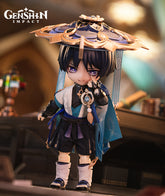
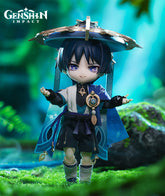



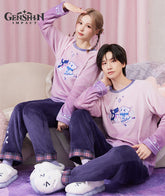
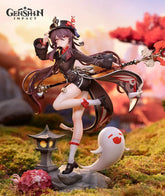
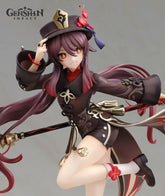
![[Official Merchandise] Genshin Impact Hu Tao Fragrance in Thaw Mechanical Keyboard](http://genshinfans.com/cdn/shop/files/ZT02_9689ce36-9513-4d72-b99b-8790f33a4731_165x.jpg?v=1691982888)
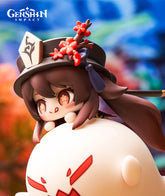
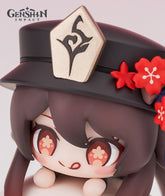
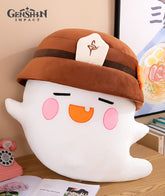
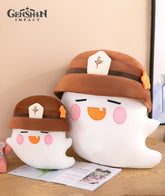
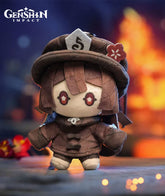
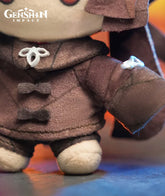
![[Official Merchandise] Hu Tao Themed Impression Series Shirt](http://genshinfans.com/cdn/shop/files/ZT01_d60fb4b0-a842-42d4-ba7c-5b67c9b7c494_165x.jpg?v=1693362051)
![[Official Merchandise] Hu Tao Themed Impression Series Shirt](http://genshinfans.com/cdn/shop/files/ZT02_065196e1-4f15-4d97-b44f-e586fa53b042_165x.jpg?v=1693362052)
![[Official Merchandise] Hu Tao Impression Brooch](http://genshinfans.com/cdn/shop/files/ZT01_c0fd5dba-2cba-40ff-9694-9087e261c7b3_165x.jpg?v=1738994940)
![[Official Merchandise] Hu Tao Impression Brooch](http://genshinfans.com/cdn/shop/files/ZT05_13f9c6e7-8142-40a0-ac8e-f81f2db20099_165x.jpg?v=1738994940)
![[Official Merchandise] Hu Tao Impression Sling Bag](http://genshinfans.com/cdn/shop/files/01_9de120b5-381f-441c-93d7-72445d11db92_165x.jpg?v=1697006693)
![[Official Merchandise] Hu Tao Impression Sling Bag](http://genshinfans.com/cdn/shop/files/02_2a4db238-8bbf-4b0e-849b-3ecb5fe9da63_165x.jpg?v=1697006694)
![[Official Merchandise] Hu Tao Ghost Night Light Lamp Boo Tao](http://genshinfans.com/cdn/shop/files/hutao-night-light-03_165x.jpg?v=1695875347)
![[Official Merchandise] Hu Tao Ghost Night Light Lamp Boo Tao](http://genshinfans.com/cdn/shop/files/hutao-night-light-02_165x.jpg?v=1695875347)
![[Official Merchandise] Hu Tao Impression Ring](http://genshinfans.com/cdn/shop/files/ZT01_84ff6f01-2b99-46aa-a69d-c9dbbfd2aa26_165x.jpg?v=1698724657)
![[Official Merchandise] Hu Tao Impression Ring](http://genshinfans.com/cdn/shop/files/ZT02_3c657011-a7fb-4357-934b-910d376922a1_165x.jpg?v=1698724658)
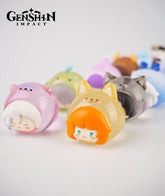
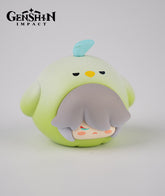
![[Official Merchandise] Hu Tao Impression Folding Fan](http://genshinfans.com/cdn/shop/files/01_51a86435-7c1c-4dc1-bd69-5059763b13c5_165x.jpg?v=1697005957)
![[Official Merchandise] Hu Tao Impression Folding Fan](http://genshinfans.com/cdn/shop/files/03_18cc5b77-3224-4d2d-b293-8f3e3bb5f832_165x.jpg?v=1697005958)
